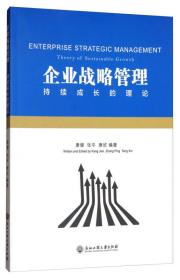
企业战略管理:持续成长的理论
正版二手,无赠品、光盘、MP3等。批量上传数据有误差,默认发一本,套装书需联系客服核实,还请见谅!
¥ 6.61 1.2折 ¥ 55 八五品
库存55件
山东枣庄
认证卖家担保交易快速发货售后保障
作者康健、张平、唐欣 著
出版社浙江工商大学出版社
出版时间2017-06
版次1
装帧平装
货号9787517823353
上书时间2024-12-10
- 最新上架
商品详情
- 品相描述:八五品
图书标准信息
- 作者 康健、张平、唐欣 著
- 出版社 浙江工商大学出版社
- 出版时间 2017-06
- 版次 1
- ISBN 9787517823353
- 定价 55.00元
- 装帧 平装
- 开本 16开
- 纸张 胶版纸
- 页数 202页
- 字数 356千字
- 正文语种 简体中文
- 【内容简介】
- 《企业战略管理:持续成长的理论》阐述了企业战略管理的基本理论和概念,说明了企业使命制订、愿景阐述、内外部分析、战略制订、战略执行、战略控制等模块的内容,《企业战略管理:持续成长的理论》主要使用英文进行内容阐述,重要的关键点和核心概念采用中英文对照的方式进行说明。《企业战略管理:持续成长的理论》可以作为管理类本科阶段的专业教材,也可以作为企业经营管理人员、管理咨询人员以及与企业战略管理人员相关的其他人员学习企业战略管理分析方法的参考资料。
- 【目录】
-
Chapter 1 Strategic Management Concept
1.1 Strategic Competitiveness
1.2 The Global Economy
1.3 Mission
1.4 Strategic Management Process
1.5 Developing a Strategic Vision and Mission
1.6 Setting Objectives
1.7 Crafting a Strategy
1.8 Implementing and Executing a Strategy
1.9 Approaches to Performing the Strategy-Making Task
1.10 Strategic Management Principle
Chapter 2 External Environment Analysis
2.1 The General, Industry, and Competitor Environments
2.2 External Environmental Analysis
2.3 Scanning
2.4 Industry Environment Analysis
2.5 Threat of New Entrants
2.6 Bargaining Power of Buyers
2.7 Threat of Substitute Products
2.8 Strategic Groups
2.9 Ethical Considerations
2.10 Rivalry Among Competing Sellers
2.11 Control and Environmental Variables
Chapter 3 Internal Environment Analysis
3.1 Analyzing the Internal Organization
3.2 Creating Value
3.3 Resources, Capabilities, and Core Competencies
3.4 Resources
3.5 Tangible Resources
3.6 Intangible Resources
3.7 Capabilities
3.8 Core Competencies
3.9 The Four Criteria of Sustainable Competitive Advantage
3.10 Value Chain Analysis
3.11 Analyzing Driving Forces
Chapter 4 Evaluating Resources and Competitive Capabilities
4.1 A Model of Competitive Rivalry
4.2 Competitor Analysis
4.3 Strategic and Tactical Actions
4.4 Competitive Dynamics
4.5 Company Situation Analysis
4.6 Typical Company Value Chain
Chapter 5 Business-Level Strategies
5.1 Customers: Their Relationship with Business-Level Strategies
5.2 The Purpose of Business-Level Strategies
5.3 Types of Business-Level Strategies
5.4 Cost Leadership Strategies
5.5 Differentiation Strategies
5.6 Focus Strategies
5.7 Focused Cost Leadership Strategies
5.8 Integrated Cost Leadership/Differentiation Strategies
5.9 Levels of Diversification
5.10 Reasons for Diversification
5.11 Value-Creating Diversification. Related Constrained and Related Linked Diversification
Chapter 6 Functional Strategies and Strategic Choices
6.1 Operational Relatedness. Sharing Activities
6.2 Market Power
6.3 Value-Neutral Diversification. Incentives and Resources
6.4 Resources and Diversification
6.5 Value-Reducing Diversification. Managerial Motives to Diversify
6.6 Learning and Developing New Capabilities
6.7 Three Basic Benefits of International Strategies
6.8 International Business-Level Strategies
6.9 Global Strategy
6.10 Acquisitions
6.11 Unbundling and Outsourcing Strategies
6.12 Offensive Strategies and Competitive Advantage
6.13 First-Mover Advantages
6.14 Customer Relationship Management Strategy
Chapter 7 Strategy Implementation
7.1 Implementing Internal Innovations
7.2 Facilitating Integ.ration and Innovation
7.3 Organizational Structure and Controls
7.4 Functional Structure
7.5 The Role of Top-Level Managers
7.6 Top Management Teams
7.7 Managerial Succession
7.8 Sustaining an Effective Organizational Culture
7.9 Establishing Balanced Organizational Controls
7.10 Innovation
7.11 Autonomous Strategic Behavior
7.12 Why the World Economy Is Globalizing
7.13 Internet Strategies for Traditional Businesses
7.14 Tailoring Strategy to Fit Specific Industry Situations
7.15 How Broadly a Company Should Diversify
7.16 Turnaround Strategies
Chapter 8 Strategic Implementation Innovation
8.1 Putting the Innovator's DNA into Practice
8.2 Technology in services
8.3 Services Marketing: Concepts, Strategies
8.4 Meeting Competitive Challenges and Acquiring Critical Resources
8.5 Acquisition Strategy
8.6 Merger, takeover, acquisition
8.7 Vertical Acquisition
8.8 Implementing Internal Innovations
8.9 Cross-Functional Product Development Teams
8.10 The decision-making process
8.11 Information is a Product
Chapter 9 Strategic Evaluation and Control
9.1 Product Diversification as an Example of an Agency Problem
9.2 How Corporate Strategies Form
9.3 Building Core Competencies and Competitive Capabilities
9.4 Key Traits to Building Core Competencies
9.5 Instituting Best Practices and Installing Support Systems
9.6 What Total Quality Management Is
9.7 What Areas Information Systems Should Address
9.8 Guidelines for Designing an Effective Compensation System
9.9 Controlling Process
9.10 Focus on organizational behavior
Chapter 10 Enterprise Growth Strategy
10.1 Entrepreneurial Management
10.2 Related Diversification and Unrelated Diversification Strategies ...
10.3 Strategic entrepreneurship
10.4 Entrepreneurship and Entrepreneurial Opportunities
10.5 Incremental and Radical Innovation
10.6 Autonomous Strategic Behavior
10.7 Design for Six Sigma
10.8 Well-structured problems and programmed decisions
10.9 Risk analysis
10.10 Growth Models with Consumer Optimization
参考文献
后记
点击展开
点击收起
相关推荐
— 没有更多了 —


















以下为对购买帮助不大的评价